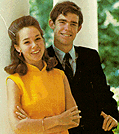|
From the beginning, each President and his family have
created a highly individual home within the Executive Mansion by furnishing and
embellishing it in their own taste. Dolley Madison expressed her warm
and vibrant personality in decorating the Presidential quarters with
bright yellow draperies and upholstery. Sedate and proper Lucy Hayes had
her bedroom walls tinted pale blue, with panels of light gray and pink.
Abigail Fillmore, a
one-time schoolteacher who had met her husband-to-be
when they attended school together, obtained Congressional funds for the
first official library in the Executive Mansion. With a dictionary,
histories, sets of Dickens, Thackeray, and other works, she filled the
bookshelves installed in the upstairs sitting room. There, she and
President Fillmore spent
many quiet evenings reading and chatting, while their daughter, Mary
Abigail, played the piano or harp.
Equally revealing possessions have moved in and out of the White House
with each successive family. With the Tafts, for instance, came
the President's many lawbooks, recalling his long and distinguished legal
career capped eventually by his appointment as Chief Justice of the
United States.
The erudite Hoovers
brought many mementos from their world travels.
South American rugs, Oriental art, caged songbirds--and books in various
languages, including their own translations from Latin of an important
16th-century volume on mining. All of which helped Lou Hoover transform
the broad, bare hall on the second floor into an inviting reception area
for guests.
To the White House from Hyde Park, New York, Franklin and Eleanor
Roosevelt shipped some of their sturdy handcrafted furniture and a
wheelchair that would carry the President along the family corridor.
During the Trumans'
time, the second floor held three pianos--appropriate
symbols of the close harmony that characterized the family from
Independence, Missouri. One piano stood in the oval room that was then
the President's study; Margaret practiced on another in her sitting room,
where she also kept her record collection, while a third--a spinet in the
hall--was often used for duets.
A few years later, when friends of President Eisenhower
visited him in the upstairs oval room, which he, too, used as a study,
they found displayed there a fascinating array of military and civilian
awards, decorations, swords, and other gifts presented by world leaders.
In his book The White House Years, the President wrote that he
received visitors in the study "informally in the evening, whenever a
somewhat homier atmosphere than could be obtained in my office was
desirable."
After the Eisenhowers and the President's prized souvenirs went their
separate ways, the changing scenes on the family floor continued to mirror,
in colors and furnishings, tastes and activities of each new group of
White House occupants.
 Mrs.
Eisenhower's feminine and frilly decor, with its
"Mamie pink" accents in flowered slipcovers and draperies, gave way to
Mrs.
Kennedy's light-blue curtains and blue-and-white furnishings that showed
to advantage against plain off-white walls in the private bedroom and
sitting-room areas. American period pieces, French antiques, and
valuable art objects began to appear in various places: the sitting halls
that share the wide corridor; the Queens' and Lincoln Bedrooms, where
visiting royalty had slept; and what was called the Treaty Room, then
decorated in Victorian style. They gave visible evidence of Jacqueline
Kennedy's program to restore the White House furnishings that awaken a
feeling of the historical past. Mrs.
Eisenhower's feminine and frilly decor, with its
"Mamie pink" accents in flowered slipcovers and draperies, gave way to
Mrs.
Kennedy's light-blue curtains and blue-and-white furnishings that showed
to advantage against plain off-white walls in the private bedroom and
sitting-room areas. American period pieces, French antiques, and
valuable art objects began to appear in various places: the sitting halls
that share the wide corridor; the Queens' and Lincoln Bedrooms, where
visiting royalty had slept; and what was called the Treaty Room, then
decorated in Victorian style. They gave visible evidence of Jacqueline
Kennedy's program to restore the White House furnishings that awaken a
feeling of the historical past.
The Yellow Oval Room on the second floor has had the same color and Louis
XVI furnishings, and has served the same functions, for the last seven
administrations. Mrs. Kennedy turned this room
into a formal drawing room, and it has proved to be the most suitable
place in the house to
entertain state guests before dinners or luncheons given in their honor.
|

